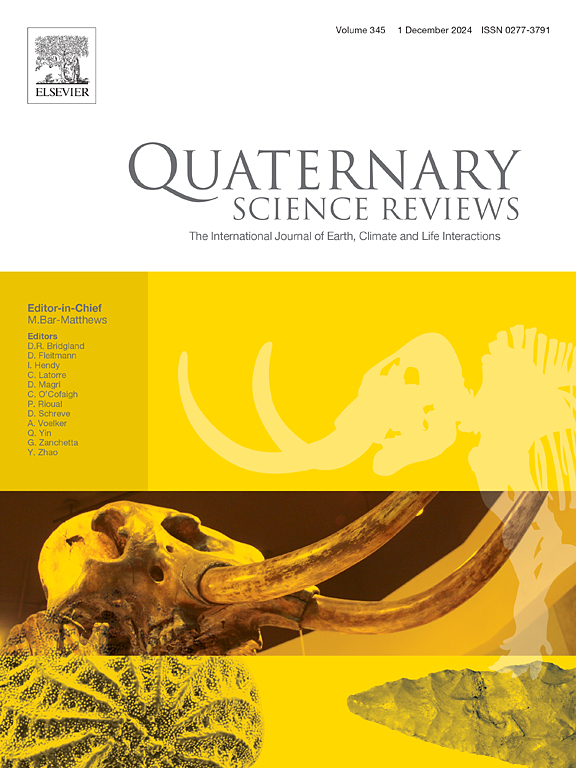Holocene summer temperature variability in the Southern Carpathians: possible North Atlantic Jet forcing and high-altitude sensitivity
IF 3.2
1区 地球科学
Q1 GEOGRAPHY, PHYSICAL
引用次数: 0
Abstract
The Southern Carpathians, a pivotal yet understudied transition zone between Atlantic and continental climate regimes, lack high-resolution summer temperature reconstructions critical for deciphering North Atlantic Oscillation (NAO) and North Atlantic Jet (NAJ)-driven Holocene climate variability. In this multi-proxy study, we use subfossil chironomids, pollen, loss-on-ignition, magnetic susceptibility, as well as major and trace element analyses from the sediments of a high alpine lake, Bâlea (2034 m a.s.l.), to reconstruct sub-century scale Holocene climate variability and environmental change. Chironomid-inferred average TJuly at the lake is 9.3 °C today. The lowest temperatures around 6 °C were found in the Lateglacial (∼13,600 cal yr BP). In the Holocene (since 8330 cal yr BP), TJuly ranged from 7.5 to 10.4 °C with cooler periods between 5500 and 4800 cal yr BP (∼8.9 °C) and around 4200 cal yr BP (∼9 °C). After 4200 cal yr BP, ln(Rb/K) ratios suggested increasing precipitation that likely affected the sediment composition of the lake. Our findings support the NAJ's summer impact in Eastern Central Europe by showing a ∼0.5–1 °C multi-decadal summer cooling in periods with a more northerly position of the summer NAJ. Chironomid assemblage composition change at 4200 cal yr BP involved the increase of Micropsectra insignilobus-type and Heterotrissocladius marcidus-type, while Micropsectra radialis-type declined. In addition, the overall chironomid population size declined pointing to decreasing lake productivity. The dominant taxon of the early- and mid-Holocene assemblages, Micropsectra radialis-type, disappeared at 2750 cal yr BP. We explained this faunal change with lake substrate change and proved the bias of the inferred increase in TJuly after 2750 cal yr BP.

南喀尔巴阡山脉全新世夏季温度变率:可能的北大西洋急流强迫和高海拔敏感性
南喀尔巴阡山脉是大西洋和大陆气候之间的关键过渡带,但研究不足,缺乏高分辨率的夏季温度重建,这对破译北大西洋涛动(NAO)和北大西洋急流(NAJ)驱动的全新世气候变率至关重要。本文通过对高寒湖泊bastlea (2034 m a.s.l)沉积物的亚化石chironomids、花粉、失燃率、磁化率以及主要元素和微量元素的分析,重建了亚世纪尺度的全新世气候变率和环境变化。如今,该湖7月的平均气温为9.3°C。冰川期(~ 13,600 cal yr BP)的最低温度约为6°C。在全新世(8330 cal yr BP以来),7月温度在7.5 ~ 10.4°C之间,较冷时期在5500 ~ 4800 cal yr BP(~ 8.9°C)和4200 cal yr BP(~ 9°C)左右。4200 cal yr BP后,ln(Rb/K)比值表明降水增加可能影响湖泊沉积物组成。我们的研究结果支持了NAJ对中欧东部的夏季影响,表明在夏季NAJ位置偏北的时期,多年代际夏季降温为~ 0.5-1°C。4200 calyr BP时摇尾虫组合组成变化主要表现为微栉虫(Micropsectra insignilobus-type)和marcidus- Heterotrissocladius -type)增加,而桡骨微栉虫(Micropsectra radialis-type)减少。此外,总体种群规模下降,表明湖泊生产力下降。早、中全新世组合的优势分类群Micropsectra radialis-type在2750 calyr BP消失。我们用湖泊底物的变化解释了这种动物区系变化,并证明了2750 calyr BP后7月推断的增加的偏差。
本文章由计算机程序翻译,如有差异,请以英文原文为准。
求助全文
约1分钟内获得全文
求助全文
来源期刊

Quaternary Science Reviews
地学-地球科学综合
CiteScore
7.50
自引率
15.00%
发文量
388
审稿时长
3 months
期刊介绍:
Quaternary Science Reviews caters for all aspects of Quaternary science, and includes, for example, geology, geomorphology, geography, archaeology, soil science, palaeobotany, palaeontology, palaeoclimatology and the full range of applicable dating methods. The dividing line between what constitutes the review paper and one which contains new original data is not easy to establish, so QSR also publishes papers with new data especially if these perform a review function. All the Quaternary sciences are changing rapidly and subject to re-evaluation as the pace of discovery quickens; thus the diverse but comprehensive role of Quaternary Science Reviews keeps readers abreast of the wider issues relating to new developments in the field.
 求助内容:
求助内容: 应助结果提醒方式:
应助结果提醒方式:


